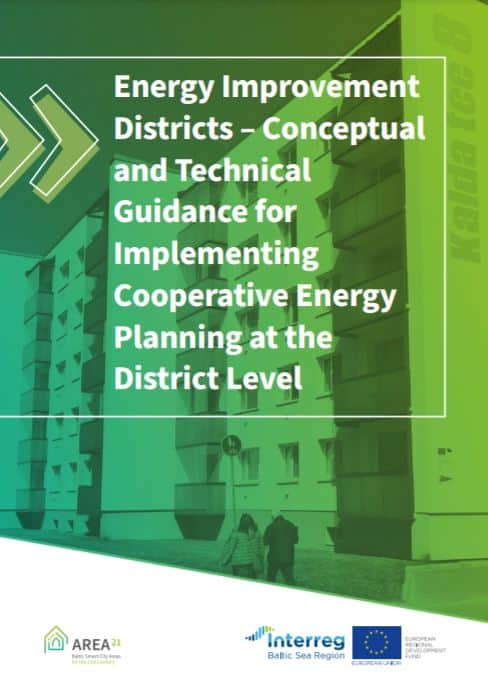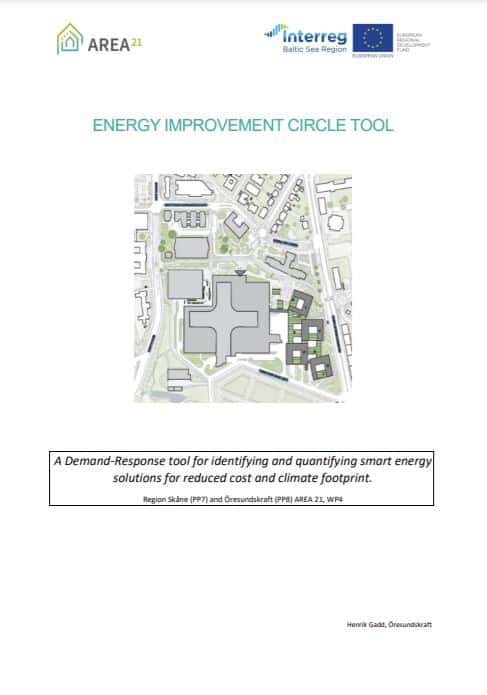AREA 21
A collaborative approach is needed in saving energy and thereby decreasing CO2 emissions in the Baltic Sea region. A radical change in behaviour of property users in increasing energy efficiency and engagement of citizens in energy planning and consumption are preconditions for energy saving.
Besides structural, technical and organisational inefficiencies, there is a lack in integrating the behavioural perspective into the holistic approach. More efforts are needed to identify incentives for a behavioural change of energy consumers as 20% of energy savings can be reached by targeting individual behaviour, according to European Environment Agency, 2013.
As key players in reaching European energy efficiency targets, cities are facing challenges to reach a greenhouse gas emission reduction. Modernisation of urban structures, infrastructures, ownership which represent the majority of the existing settlement patterns in the Baltic Sea region and entire EU represents an unveiled potential. Sectoral fragmentation as well as lack of cooperative integrated approach between public authorities, energy utilities and property owners are obstacles to overcome.
Budgets
in numbers
-
2.55MillionTotal
-
1.89MillionErdf
-
0.10MillionEni + Russia
-
0.00MillionNorway
Achievements
The project established Energy Improvement Districts (EID) in Hamburg, Helsingborg, Tamprere Tartu, Kohtla-Järve, St. Petersburg and Lublin where local and regional public authorities, energy utilities, public property owners and users worked together. The stakeholders applied the collaborative approach to property users' behavioural change to increase energy efficiency. The partners used upgraded ICT-based tools for visualization of energy consumption and thus providing incentives for the property owners to lower their energy consumption.
AREA 21 partners succeeded in upscaling energy efficiency in buildings from the level of a single house up to the level of entire city districts. In addition, the partners introduced new policy recommendations and guidelines on collaborative processes in strategic planning.
New Guidance for Cooperative Energy Planning
The project developed a holistic guideline that helps understand and follow the process of planning and establishing an Energy Improvement District. The guideline contains information on setting up a context-specific concept, developing a strategy, as well as implementing the EID. It addresses local, regional and national actors in energy planning aimed at reduction of CO2 emissions and increase of energy efficiency at the district level. Clearly defined features of the EID concept can be transferred to other context-specific cases. Such features as initiation of an EID, area identification, definition of boundaries, understanding of cooperative formats, financing and incentives are concrete steps to be taken into consideration.
Energy consumers empowered in energy planning
Three different ICT tools were developed and tested in seven piloting regions. The tools can monitor energy (electricity and heating) and water consumption in buildings as well as single apartments. Thus, the web-based tools helped the owners of apartments and buildings to display the energy consumption of single housing units and measure saving potentials. Similarly, the tools could be applied at the district level in order to quantify smart energy solutions with a reduced cost and climate footprint. Thus, these tools were tested in the Helsingborg Hospital Area in Sweden and indicated an annual saving potential of EUR 18,700 and 160 tons of CO2 emissions.
Continued efforts in a new format
The lessons learnt within the partnership have been taken further in a new format of the project AREA 21+ action which introduces measures from the selected EIDs and demonstrates the potential of the EID concept of supporting integrated energy planning and emission reductions. Furthermore, a continued transfer of ICT tools to other cities and regions in the Baltic Sea region is planned.
The project AREA 21 used EUR 2.17 million and improved planning processes by bringing together local and regional public authorities, energy utilities, public property owners and users. The new holistic approach enabled to upscale energy efficiency in buildings from the level of a single house up to the level of entire city districts.
Outputs
Energy Improvement Districts – Conceptual and Technical Guidance for Implementing Cooperative Energy Planning

ICT-based tools for involving citizens and property users in energy planning

Project Stories
-
29.03.2021
Cooperation as the key to a climate-neutral Baltic Sea region
A common challenge for the countries in the Baltic Sea region is how to produce green and climate-neutral energy. In fact, as much as 75% of the EU greenhouse gas emissions still come from energy use and production. Cooperation and sharing good practices in Interreg projects, such as LowTEMP, Baltic Integrid and Area 21, can be a game-changer in accelerating the energy transition in the region.Read full story -
04.12.2019
What Russian partners do in Interreg projects: 5 examples from the Baltic Sea region
As many as 43 Interreg Baltic Sea Region projects are working together with Russian partners, showcasing that the same cause unites people beyond borders. From innovating businesses to saving energy and improving mobility – Russian partners are active in all thematic fields of the Programme. But what do they actually do?Read full story -
11.06.2018
Rethinking energy in the Baltic Sea region
Establishing more sustainable and competitive energy systems that have a less harmful impact on the environment are among the core challenges for the Baltic Sea region. Two Interreg projects, AREA 21 and LowTEMP, unlock energy efficiency potential by triggering public and private strategic partnerships for energy production and management and by offering low temperature district heating technology for more efficient heating systems.Read full story
Partners
HafenCity University Hamburg
- TownHamburg
- RegionHamburg
- CountryGermany
- RepresentativeJörg Knieling
- Phone
- E-Mail
- Web
Tampere University of Applied Sciences Ltd
- TownTampere
- RegionPirkanmaa
- CountryFinland
- RepresentativeAija Paananen
- Phone
- E-Mail
- Web
Peter the Great St.Petersburg Polytechnic University
- TownSt.Petersburg
- RegionCity of St. Petersburg
- Country
- RepresentativeYury Nurulin
- Phone
- E-Mail
- Web
Kohtla-Järve Town Government
- TownKohtla-Järve
- RegionKirde-Eesti
- CountryEstonia
- RepresentativeJelena Dulneva
- Phone
- E-Mail
- Web
Tartu Regional Energy Agency
- TownTartu
- RegionLõuna-Eesti
- CountryEstonia
- RepresentativeMartin Kikas
- Phone
- E-Mail
- Web
City of Tampere
- TownTampere
- RegionPirkanmaa
- CountryFinland
- RepresentativeElina Seppänen
- Phone
- E-Mail
- Web
Region Skåne
- TownLund
- RegionSkåne län
- CountrySweden
- RepresentativeStig Persson
- Phone
- E-Mail
- Web
Öresundskraft AB
- TownHelsingborg
- RegionSkåne län
- CountrySweden
- RepresentativePatrik Hermansson
- Phone
- E-Mail
- Web
Free and Hanseatic City of Hamburg
- TownHamburg
- RegionHamburg
- CountryGermany
- RepresentativeSteffen Sperlich
- Phone
- E-Mail
- Web
City of Lublin
- TownLublin
- RegionLubelski
- CountryPoland
- RepresentativeMonika Klos
- Phone
- E-Mail
- Web
-
Project managerJörg KnielingHafenCity University Hamburg
-
Legal representativeStephanie EgerlandHafenCity University Hamburg
-
Financial managerJakob MarcksREM Consult
-
Communication managerKimberly TatumHafenCity University Hamburg



